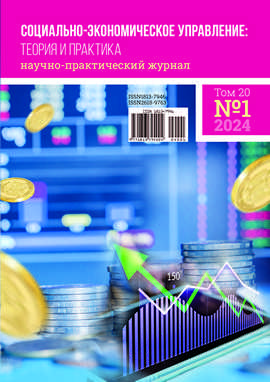СТИКЕРЫ КАК КРЕОЛИЗОВАННЫЙ ТЕКСТ
DOI:
https://doi.org/10.22213/2618-9763-2024-1-88-95Ключевые слова:
герменевтический подход, соотношение компонентов, креолизованный текст, стикерАннотация
Статья посвящена исследованию креолизованных текстов, которые в последние десятилетия становятся, наряду с традиционными текстами, одним из ключевых направлений современной лингвистики и коммуникационных исследований. Значительное внимание в работе уделяется изучению способов взаимодействия вербального и невербального компонентов, т. к. такие семиотически осложненные тексты возникают в цифровых сферах и представляют собой комплексное единство языковых и неязыковых элементов. Отмечается, что взаимодействие текстовой части, изображений и других элементов создает уникальную коммуникативную среду, в состав которой может входить стикер как особая разновидность креолизованного текста, для исследования которой эффективно применять методы герменевтического подхода, который позволяет рассмотреть их как форму выражения эмоций и чувств. Важно подчеркнуть, что в сетевом взаимодействии пользователей, где часто отсутствует невербальная обратная связь, изучение стикеров с точки зрения герменевтики позволяет выявить, как эти символы используются для передачи эмоционального содержания и как они взаимодействуют с вербальным текстом для создания полноценного коммуникативного акта. В статье рассматриваются различные трактовки термина «креолизованный текст», что позволяет выделить их общие черты и особенности, а также проследить эволюцию такого явления, обобщаются типы взаимоотношений вербального и невербального кодов в такого рода тексте, представленные в трудах различных исследователей. Статья дополняет теоретический аппарат исследований в области теории коммуникации за счет выделения нового типа взаимодействия компонентов, а именно модального, в структуре стикеров, наряду с комплементарным и интерпретативным на примере стикерпака к юбилею А. С. Пушкина, что актуально в контексте особенностей функционирования стикеров.Библиографические ссылки
Методы анализа текста и дискурса / С. Тичер, М. Мейер, Р. Водак, Е. Веттер; пер. с англ. Xарьков: Гуманитарный центр, 2009. 356 с.
Ленкова Т. А. Герменевтика как основа анализа креолизованного медиатекста // Litera. 2022. № 7. С. 60-69. DOI: 10.25136/2409-8698.2022.7.38371
Байдавлетов А. Ю., Фаткуллина Ф. Г. Креолизованный текст в интернет-дискурсе (на материале башкирского языка) // Мир науки, культуры, образования. 2021. № 2 (87). С. 412-413. DOI: 10.24412/1991-5497-2021-287-411-413. EDN: SPZZBS
Баев Е. В. Использование креолизованных текстов для повышения уровня лингвистической вежливости высказывания в виртуальной коммуникативной среде // Филологические науки. Вопросы теории и практики. 2021. № 3. С. 717-721. DOI: 10.30853/phil210068. EDN: TQYYGA
Байдавлетов А. Ю., Фаткуллина Ф. Г. Функционально-семантические особенности интернет-дискурса на башкирском языке // Мир науки, культуры, образования. 2020. № 4 (83). С. 459-461.
Крылов Ю. В. Жанр невербального ответа в виртуальной коммуникации // Verba. Северо-Западный лингвистический журнал. 2022. № 2 (4). С. 19-35.
Шинкаренкова М. Б. Метафорическое моделирование художественного мира в дискурсе русской рок-поэзии: диссертация на соискание ученой степени кандидата филол. наук. Екатеринбург, 2005. 314 с.
Пойманова О. В. Семантическое пространство видеовербального текста: диссертация на соискание ученой степени кандидата филол. наук. Москва, 1997. 237 с.
Чудакова Н. М. Концептуальная область "Неживая природа" как источник метафорической экспансии в дискурсе российских средств массовой информации (2000-2004 гг.): диссертация на соискание ученой степени кандидата филол. наук. Екатеринбург: Урал. гос. пед. ун-т, 2005. 277 с.
Sauerbier S. D. Typen von Wort-Bild-Relationen in den zeitgenössischen Künsten. Eine Übersicht in Beispielen. Kunst & Unterricht Praxis Deutsch. Sonderheft. 1978. Pp. 57-98.
Чудакова Н. М. Концептуальная область "Неживая природа" как источник метафорической экспансии в дискурсе российских средств массовой информации (2000-2004 гг.): диссертация на соискание ученой степени кандидата филол. наук. Екатеринбург: Урал. гос. пед. ун-т, 2005. 277 с.
Ворошилова М. Б. Креолизованный текст: аспекты изучения // Политическая лингвистика. 2007. № 21. С. 75-80.
Vian Jr. O., Rojo R. Letramento multimodal e ensino de línguas: a Linguística Aplicada e suas epistemologias na cultura das mídias // Raido. 2020. No. 14 (36). Pp. 216-232. DOI: https://doi.org/10.30612/raido.v14i36.12045
Щурина Ю. В. Комические креолизованные тексты в интернет-коммуникации // Вестник Новгородского государственного университета. 2010. № 57. С. 82-86.
Оптимизация речевого воздействия: коллективная монография / Ю. А. Сорокин [и др.]; отв. ред. Р. Г. Котов. Москва: Наука, 1990. 240 с. С. 180-186. EDN: UWKFKR
Бернацкая А. А. К проблеме "креолизации" текста: история и современное состояние // Речевое общение. 2000. № 3 (11). С. 104-110. EDN: YPNMHD
Ленкова Т. А. Герменевтика как основа анализа креолизованного медиатекста // Litera. 2022. № 7. С. 60-69. DOI: 10.25136/2409-8698.2022.7.38371
Сонин А. Г. Понимание поликодовых текстов: когнитивный аспект. Москва, 2005. 220 c.
Загрузки
Опубликован
Как цитировать
Выпуск
Раздел
Лицензия
Copyright (c) 2024 Д О Бральнин

Это произведение доступно по лицензии Creative Commons «Attribution» («Атрибуция») 4.0 Всемирная.


